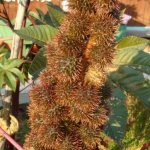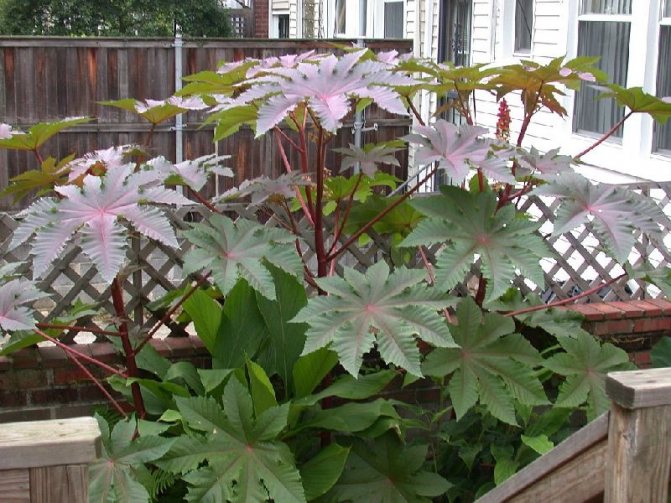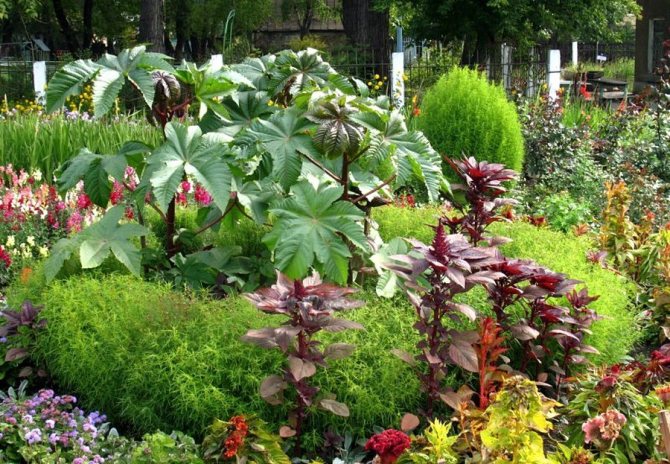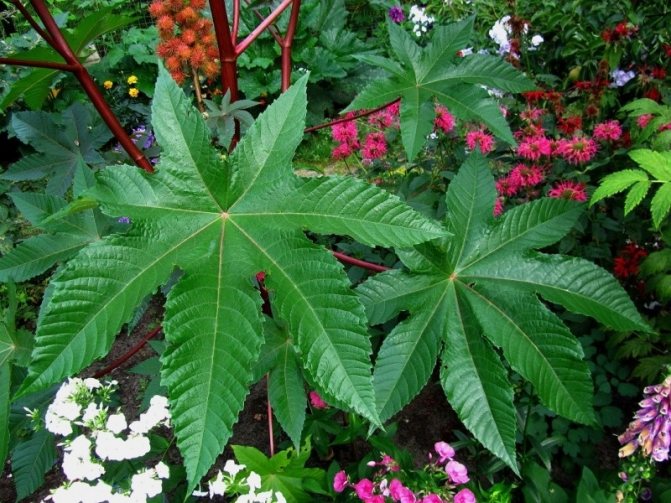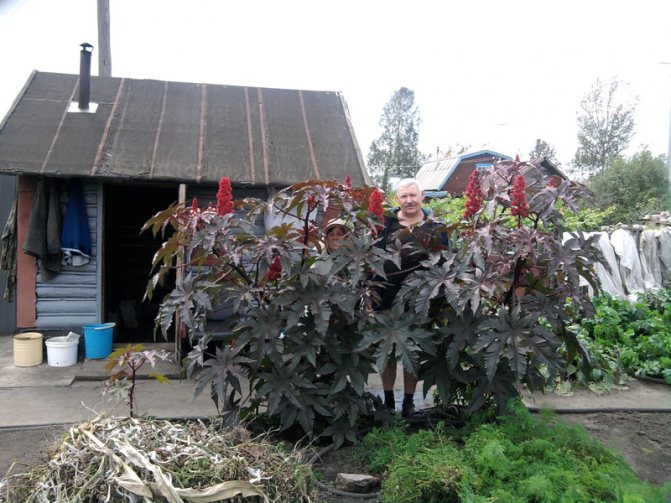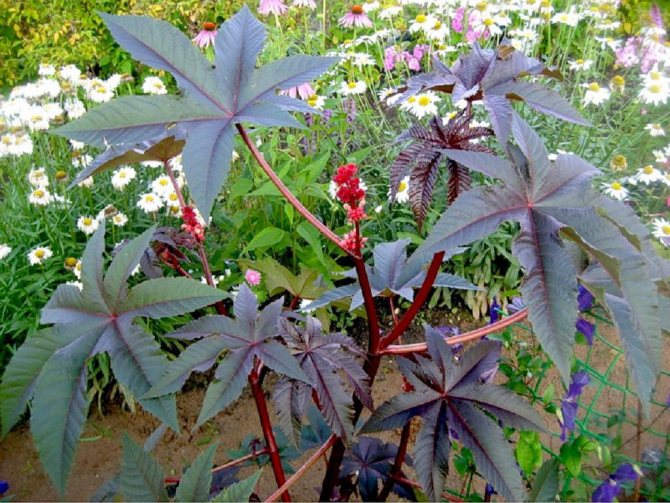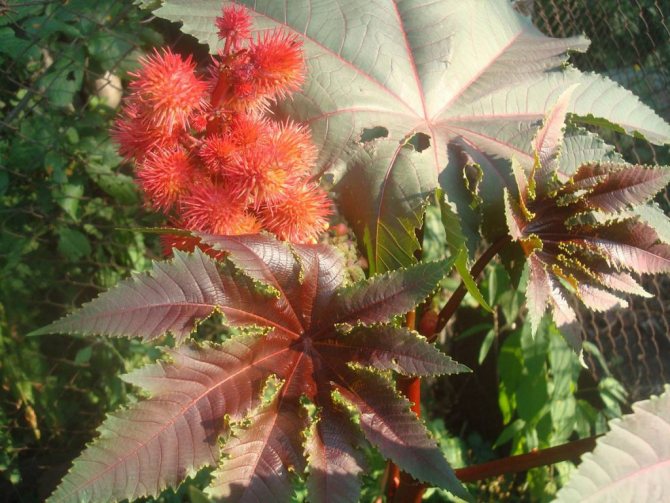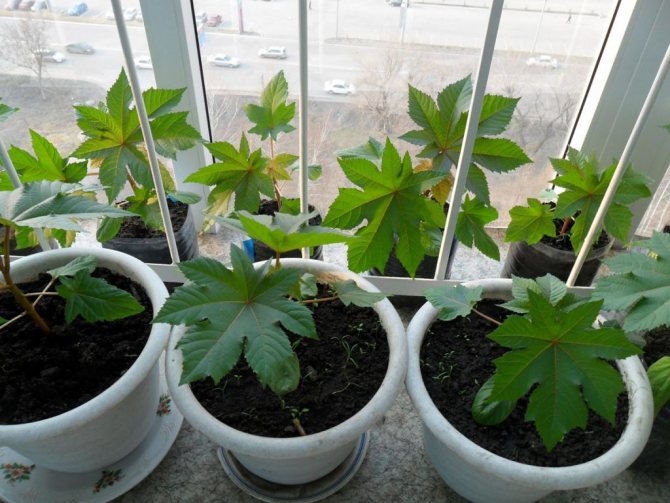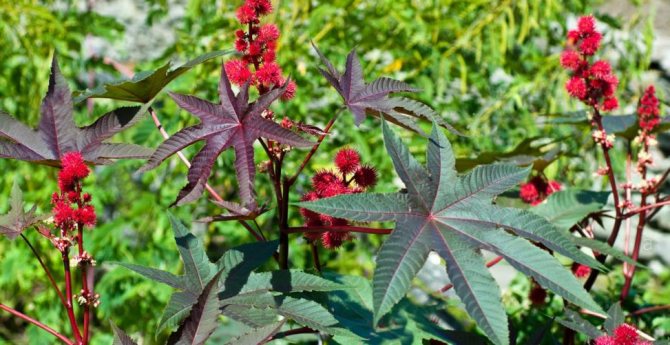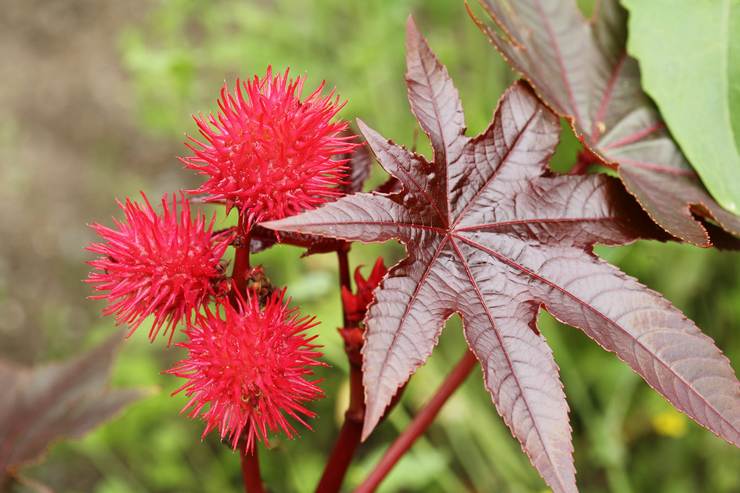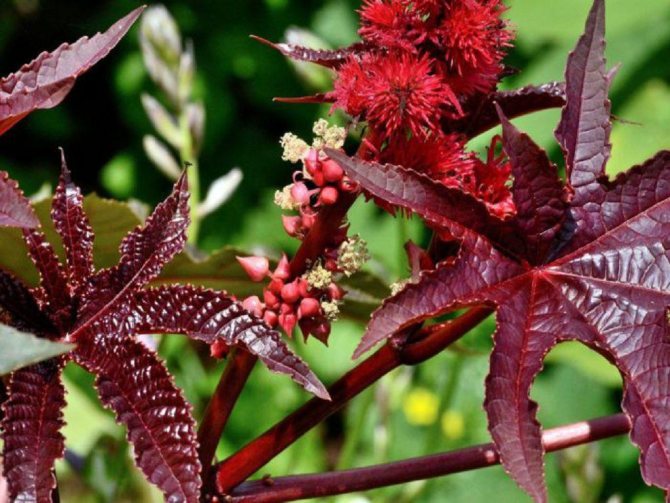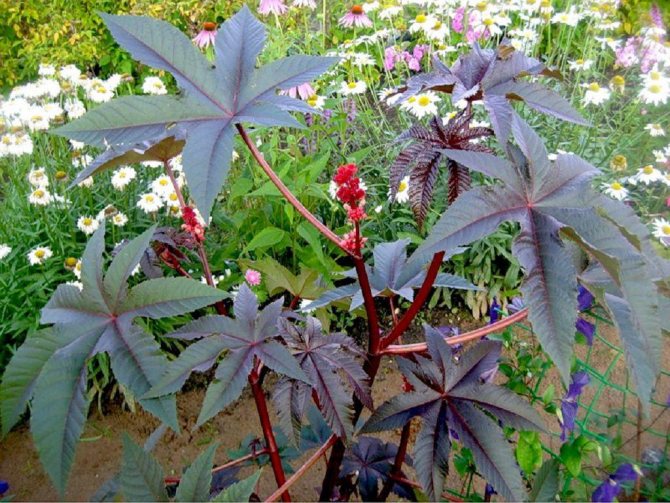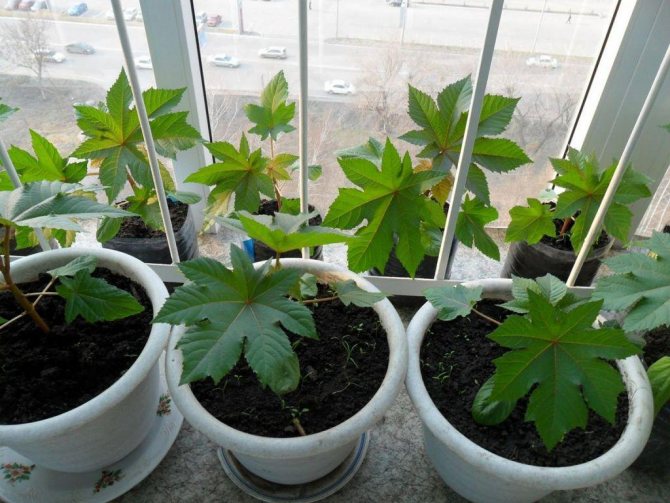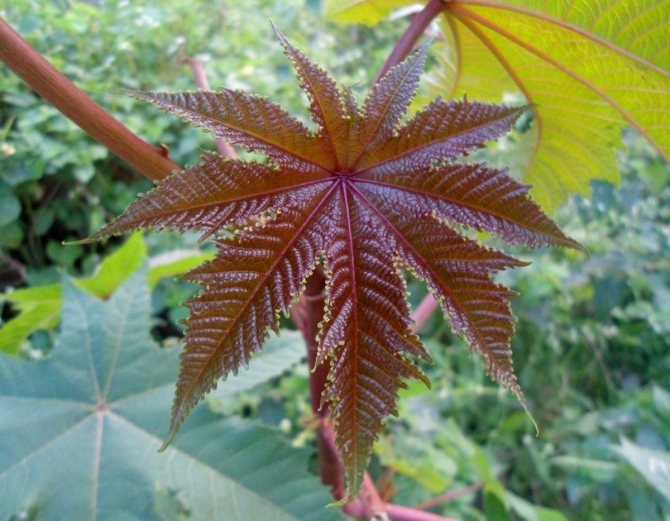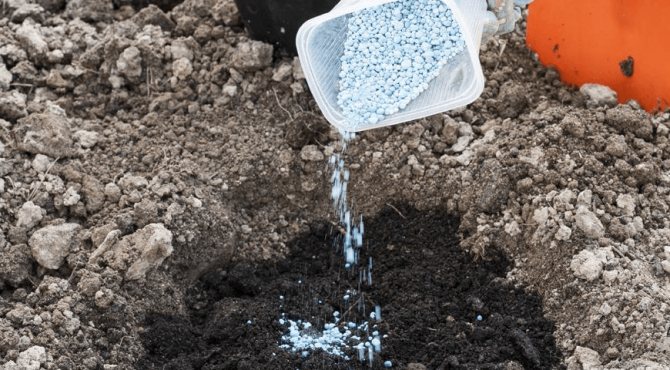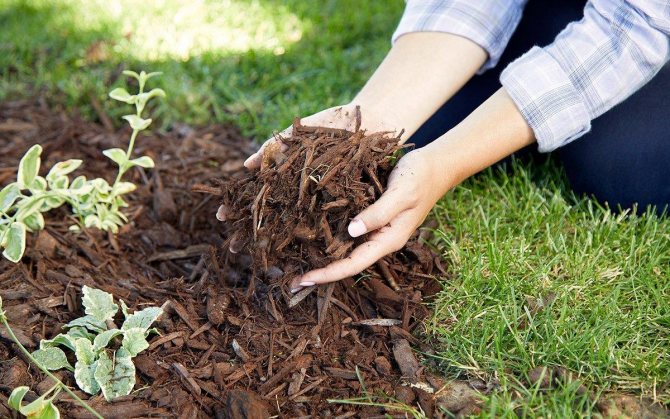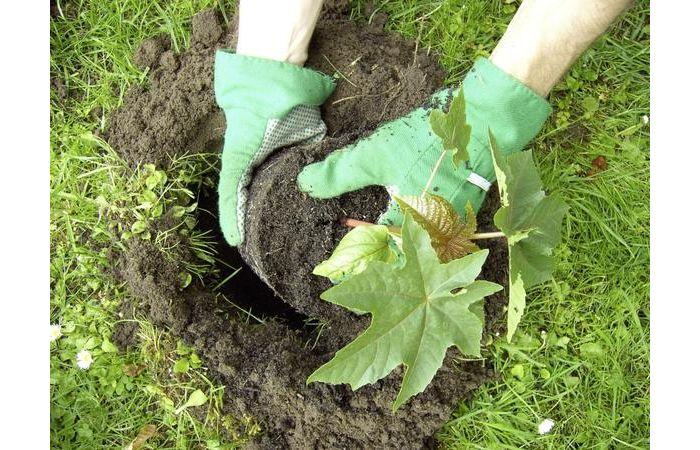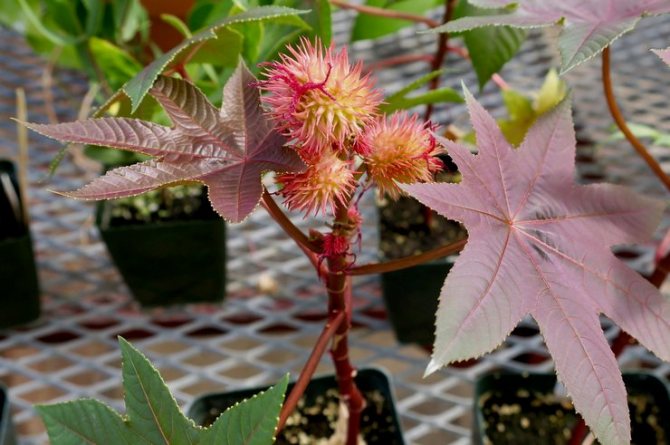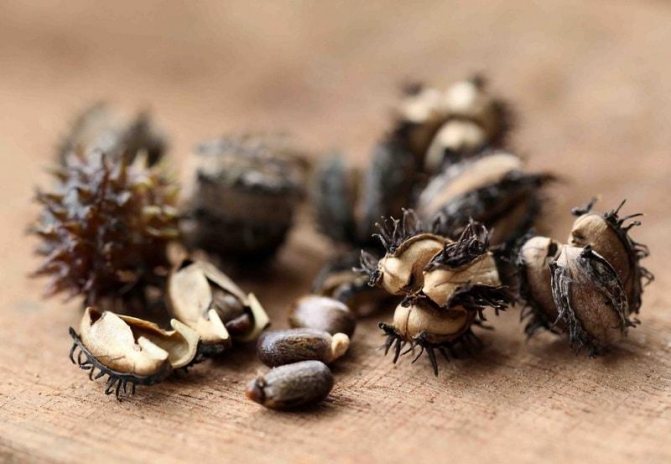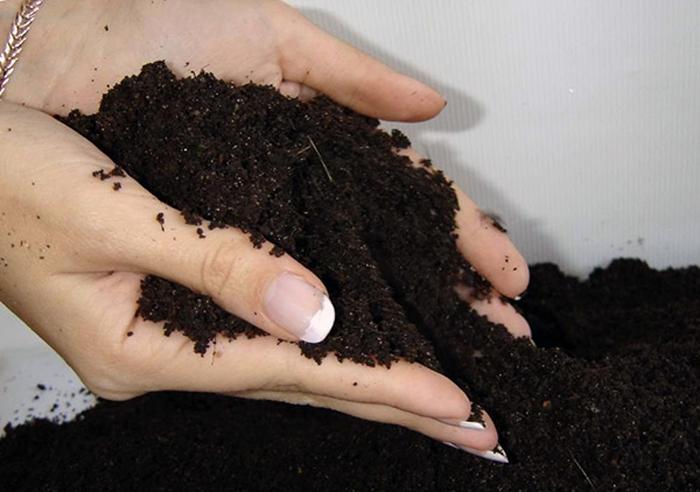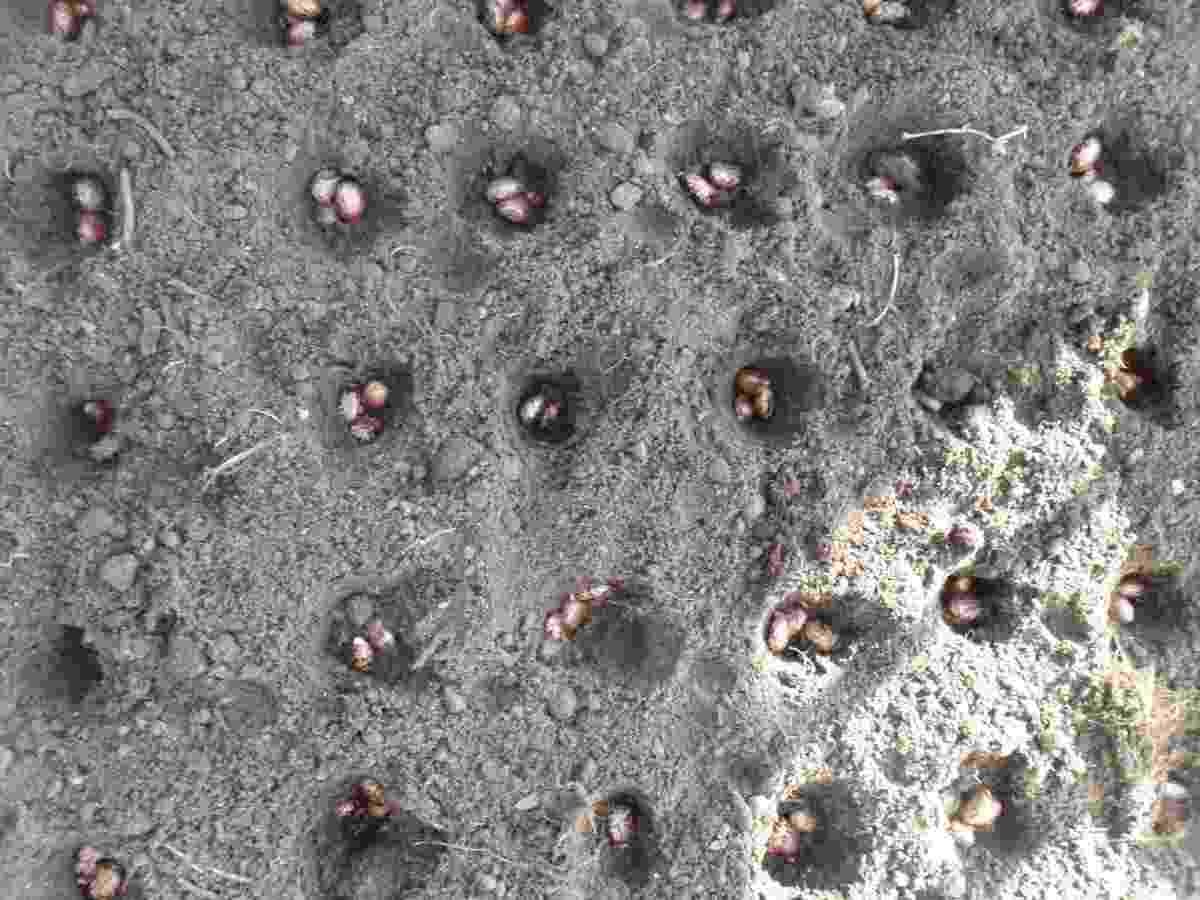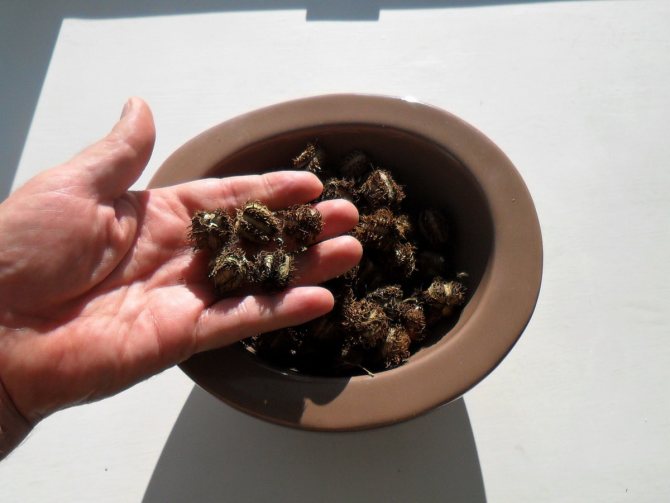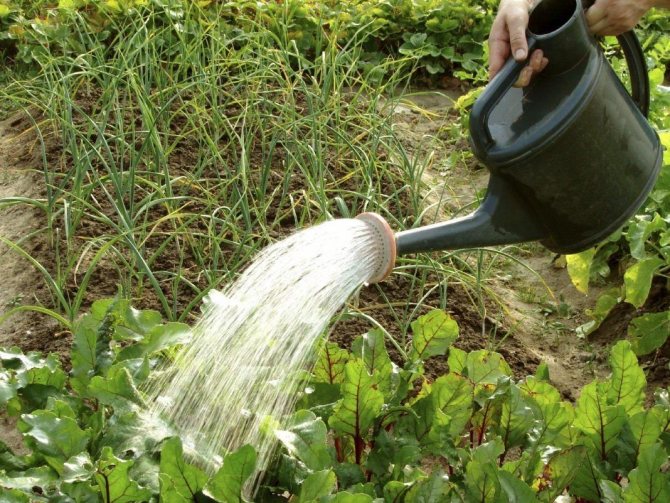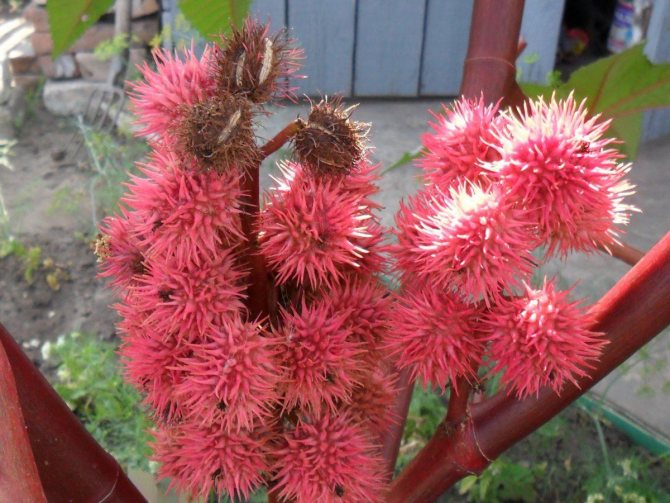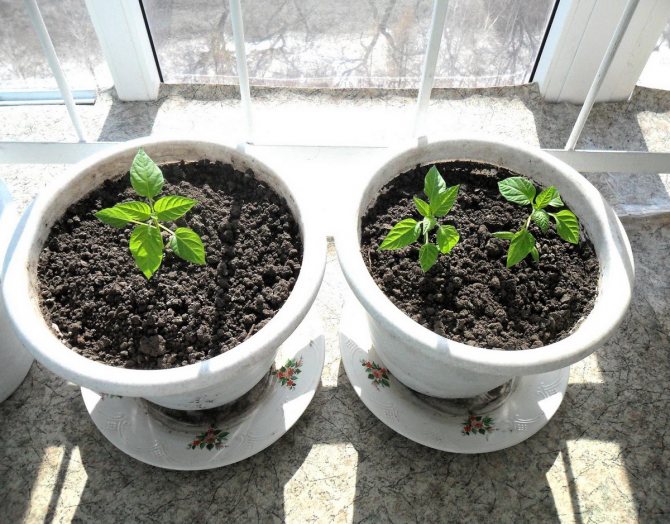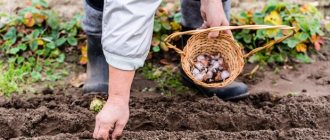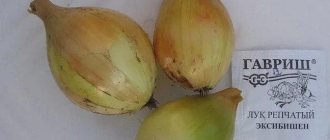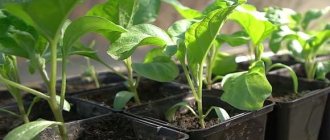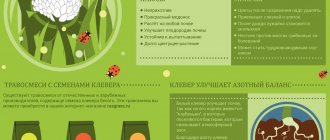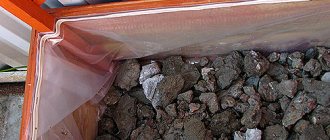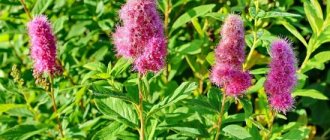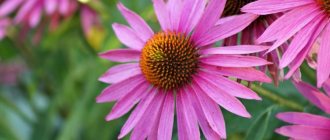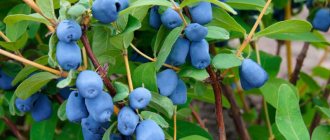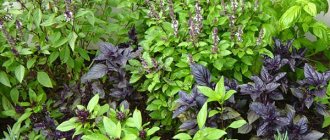Planting castor bean for seedlings in 2020 should be based on the recommendations of the lunar calendar, as well as the characteristics of the cultivation region (its climate, relief). Favorable days for planting, as a rule, fall on the last decade of March or the first half of April. To decorate the garden with a beautiful, exotic plant, it is also necessary to seriously approach the choice of a variety, on which the cultivation technique will also depend.
Features of castor bean
Castor oil is a prominent representative of the Euphorbia family. Africa is her homeland. In the wild, the plant is found in the north and east of the continent. Castor bean has been cultivated as a cultural species since the second half of the 18th century. Then almost every garden in Britain was decorated with this flower. The plant was brought to Europe from India in the 19th century, where oils were obtained from it.
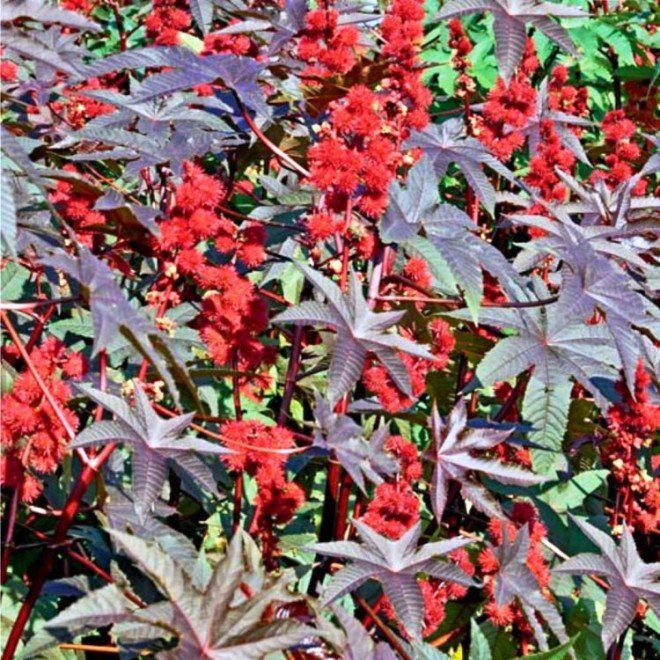
Flowering castor bean bush
Attention! In Russia, castor bean can only be grown as an annual plant.
Castor oil plant is the only representative of the species. It grows best in loose, sun-warmed and well-hydrated soils with a high nutrient content. The plant has a powerful stem and beautiful large leaves, the width of which reaches 80 cm. Most often they have a rich green color with prominent veins. Inflorescences resemble panicles and are densely arranged. After the castor oil plant, the care of which does not require much effort, has faded, oval-shaped fruits with thorns form on the stem. They are quite large in size.
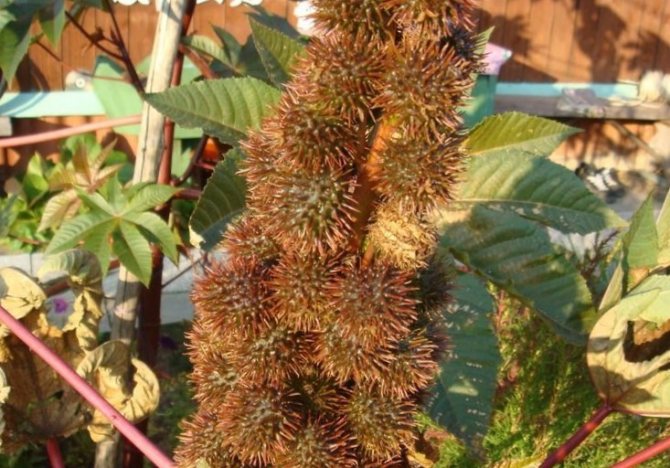

Ripe fruits
Flower care
- Being a completely unassuming plant, castor oil plant, however, needs regular and high-quality watering, especially during the formation of flower stalks and at the stage of fruit ripening.
If the gardener wants to decorate his plot with powerful, well-flowering bushes, it is enough to provide them with abundant watering. The optimal schedule is one in which each plant receives at least ten liters of water every five days.
- The second important point concerns the need for feeding. Before flowering, castor bean needs nitrogen fertilizers, and during the laying of inflorescences, potassium-phosphorus fertilizers.
- In order for the root system of intensively growing young plants to keep up with the soil, it is necessary to tie them up to reliable supports. Over time, when the castor oil plant grows, the need for supports will disappear by itself.
- With a seedless cultivation method, the area with newly emerged seedlings must be carefully weeded out so that the weeds do not interfere with the formation of roots. In a very short time, weeding will lose its relevance: castor bean bushes that have gone into growth will displace all other vegetation from their site.
- It is advisable to loosen the soil at the roots of the castor plant periodically. Mulching the soil with small pebbles or pieces of bark can save you from this responsibility.
With the onset of frost, castor bean bushes must be carefully dug up and placed in a compost pit.
Classification of castor bean species
Agapanthus: planting and care in the open field
Several types of castor bean are known. Most of them are completely different from each other. The most famous are:
- Borbon view.It has a red trunk, in structure it looks more like a tree with large glossy leaves.
- Zanzibar view. The trunk reaches two meters. It has huge dark red leaves.
- Indian or Cambodian species. Its height is only 1.2 m, which is not enough for a representative of such a family. The leaves are dark green in color.
- A variation of Gibson. The plant can grow up to one and a half meters. The leaves are dark red.
In Russia, the most common variety is "Kazachka". It has a powerful stem and beautiful flowers. The plant blooms throughout August and September, but feels great until the first frost.
Biological description
In the climatic conditions of the tropics and subtropics, castor bean, growing in a wild or cultivated form, is an evergreen plant, reaching ten meters in height. In countries with a temperate climate (such as Russia), it is grown as an annual shrub, the maximum height of which does not exceed three meters.
The erect, branching stems of this extraordinarily showy palm-like plant can be colored purple, pink, red and even black. Hollow from the inside, from the outside they are covered with a thin layer of gray waxy bloom.
In the video - castor oil plant in the open field:
Castor bean leaves (huge, up to eighty centimeters in length) can have from five to nine pointed unequally-toothed rays, giving them a resemblance to maple leaves. The color of the leaf blades, equipped with 20-50 cm petioles, varies - depending on the variety - from dull green to dark purple in color.
In summer, many axillary or terminal racemose inflorescences, consisting of white or creamy small flowers, appear on the shrub. Their numerous stamens are grouped in branching bunches, and the pistils with fringed stigmas and tripartite columns are colored light yellow, red or crimson.
Since the castor oil plant is a monoecious plant, its male flowers are located in the lower part of the inflorescence, and the female flowers are at the top. Its fruits - spherical prickly bolls, the diameter of which does not exceed three centimeters, make the castor oil plant even more attractive.
Ripe seeds - oval, smooth and shiny - have a mosaic pattern of light pink, brown and pink in color, contrasting with the background color, ranging from gray to reddish brown. The color and shape of the seeds (convex on one side, flat on the opposite and provided with a longitudinal seam in the middle) gives them a resemblance to tropical mites, thanks to which the plant got its name.
Castor oil plant: growing from seed, when to plant for seedlings
Rhododendron: planting and care in the open field
Castor bean can grow from seeds that have fallen into the ground, but it is also bred by growing seedlings. In central Russia, seeds begin to be prepared for planting from mid-April. In the southern regions, this can be done a month later. For seedlings to remain healthy, they need ten hours of daylight. It can be provided with additional lighting.
Before sowing, the seeds must be processed to get rid of the thick shell that makes it difficult for the sprout to exit. Scarification takes place with sandpaper. It is used to treat the surface of each seed. After the procedure, the germination process will accelerate several times. After processing, the seed is soaked in a growth-stimulating composition or ordinary water for a day.
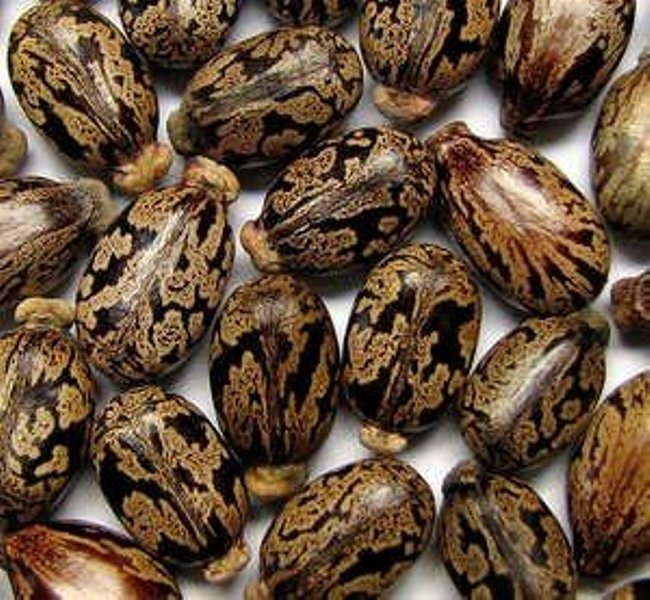

Castor bean seeds
Plastic containers are used for planting. They are half filled with nutrient soil. Then the seeds are spread over the surface, pressing 20-30 mm. Scarified castor bean seeds sprout on the third or fourth day.
Home seedlings are developing very actively.After the first leaves appear, it is necessary to rearrange the containers to a cooler, but well-lit place.
Attention! The room temperature should not be lower than 15 ° C.
As the flower grows, the container is filled with additional soil. This is done until it is full. If the castor bean, planting and caring for which is quite simple, develops too quickly, it needs an additional transplant into a more spacious pot. The size of the shoots before planting in the ground should not exceed 100 cm in height. When the threat of night frosts has passed, the plants are planted outside. To reduce the likelihood of injury to the root system, it is better to do this with a clod of earth.
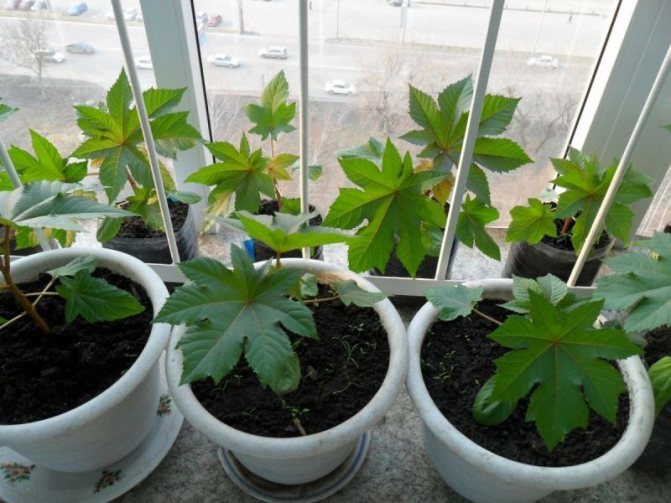

Dive seedlings
Influence of toxins, description of the action of caster on the body
The danger of the ricin protein is mainly determined by the fact that penetrating into the cell, it blocks the activity of ribosomes, disrupting protein synthesis. Why the automatic self-destruction of the cell turns on. The body has no defense against ricin due to the fact that ricin mimics friendly proteins, which the cell's defenses do not see as dangerous.
In the stomach and intestines, ricin destroys the mucous membrane and enters the bloodstream, which spreads it throughout the body, causing severe destruction of the tissues of internal organs. The liver, spleen and kidneys are particularly affected.
The toxins of the bush cannot overcome the skin, so contact with it for poisoning is not enough if you wash your hands. If chickens or pigs have been poisoned with caster, then their meat will be suitable for food only after careful removal of toxic blood and internal organs.
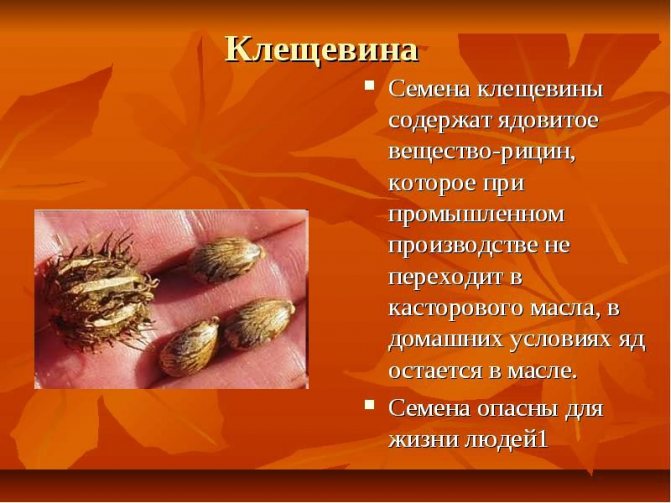

Castor bean seeds contain the poison ricin
Features of care in the garden
Correct care of castor oil plant consists of several procedures. Watering should be abundant (a bucket of water per bush), but not too frequent (once a week). The place where the plant is located should be sunny and sheltered from the wind.
Important! In some cases, the stem of the plant is tied to a support.
When deciding how to feed the castor oil plant for rapid growth, you need to take into account its size and needs. The plant responds well to nitrogen compounds. It is better to start feeding a couple of weeks after planting in the ground. The soil in which the castor oil plant will grow, when to plant it, you can find out on the Internet, should be nutritious.
You can not sow culture where children and animals are. This is a deadly risk for people who are hypersensitive to such plants. Even when using gloves, wash your hands with soap and water after handling the flower.
Important! When choosing a place for a plant, it is worth remembering that castor oil plants are poisonous.
Landing in the ground
You can transplant the culture to a permanent place after the onset of stable warm weather. This prerequisite is associated with castor oil intolerance to short-term frosts, as well as prolonged cold snaps. The soil should reach a value of 13-15 ° C. To place an exotic palm tree, they choose the southern side of a solid fence or a wall of an outbuilding. Castor bean is often planted near the house, because the smell of its flowers scares off flies.
Since the plant has a high growth rate, it needs a lot of nutrients. A site with a large humus layer is set aside for planting. If the soil is poor, when preparing the land, when the site is dug up, peat and humus are preliminarily distributed in even layers. Clay soil is lightened with sand. Compost can be used as a “natural baking powder”, which also nourishes the soil with macro- and microelements.
When the seedlings are hardened, and a stable warmth has come, they begin to plant the grown seedlings. Basic steps:
- A hole is dug on the site, the dimensions of which correspond to the earthen coma of the planting material.
- Pour 30-40 g of complete mineral fertilizer (nitrophoska) into the recess, add soil, mix. This helps prevent root burns.
- A seedling is placed with a stem deepening by 2-3 cm.
- A small roller is made around the perimeter of the hole so that the water does not spread during watering.
- Moisturize abundantly.
- After water has been absorbed, the trunk circle is mulched with peat to prevent rapid evaporation of moisture and the formation of an airtight crust.
When and how it blooms
The plant has rather small flowers, collected in a brush. There are male and female inflorescences. The former have a pistil and are located in the upper part of the stem. The latter have stamens, and they grow below. The fruits hide in the foliage and are covered with thorns. The boxes are colored yellow, pink and purple, and the seeds are copper-colored with an original pattern of brown lines.
The plant is pollinated by the wind. This should be taken into account when deciding how and where to plant castor oil plants from seeds. Flowering begins in late July or early May and can continue until the very cold. Blooming castor oil plant literally transforms the site.
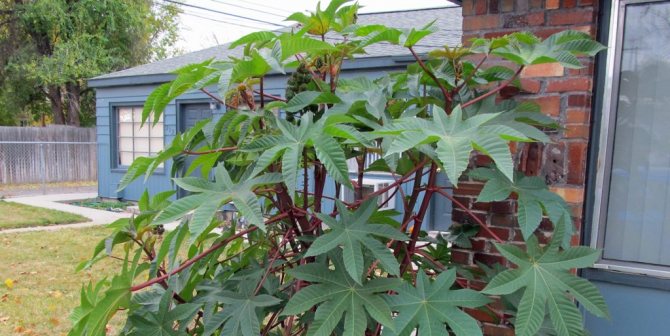

Plot decoration
Inpatient treatment
The poison ricin can be found in the body on the basis of laboratory tests. If the diagnosis is confirmed, then the patient is placed in the intensive care unit and a number of therapeutic measures are carried out, which are aimed at stabilizing the general condition:
- Blood transfusion is performed if necessary.
- Intravenous infusion of saline and glucose is indicated.
- Anesthetic narcotic drugs are used.


In case of impaired renal function, medications are prescribed that stimulate the passage of urine. Oxygen treatment gives a good result. With this type of poisoning, blood circulation is disrupted, which means that all cells suffer from a lack of oxygen and eventually die. The victim is constantly under the supervision of resuscitation doctors, supportive therapy and symptomatic treatment are performed.
Treatment of intoxication, which is provoked by castor bean, is a very difficult task even in a hospital setting, with modern equipment and medicines. Usually, for a violation of the functions of one organ, failures begin in other important organs and systems. A catastrophic situation develops in a very short time, and no matter how hard doctors try, they often lose in the struggle for a person's life. Even if a person can be saved, the internal organs will no longer function as before. A person is left with a chronic illness or disability for life.
Increasingly, young children are admitted to hospitals who have been poisoned by castor bean seeds. The worst thing is that only a few can be saved, the rest of the children die in a short time.
Post-flowering care
Castor oil plant cannot survive severe frosts, so the next year you have to plant it again.
Before winter comes, some gardeners collect castor bean seeds for planting. This is done at the end of November. However, the seeds do not always fully ripen. It is much easier to buy them at a seed store, which sells already selected material with good germination. Self-collected seeds can be stored for no more than four years.
To get seed, you need:
- Choose the fluffiest inflorescence, removing the rest of the peduncles from the stem.
- Carefully pick and split the grown and dried fruits.
- Dry the resulting seeds for several weeks and put them in canvas bags for storage. When winter passes, it will be possible to grow seedlings from them.
Important! The seeds are no less poisonous than the plant itself, so they must be kept away from children and animals.
Benefit and harm
Castor bean seeds contain a high percentage of fatty oil, which is why they are used by pharmacists in the process of making castor oil. Also, the plant is used for the preparation of cosmetic products.
At the same time, do not forget how dangerous the decorative culture is for both animals and people. The flowers and seeds of castor bean contain the most dangerous poisonous substance - ricin. Only 6.5-7 g of consumed semen will become a deadly poison for an adult, and 2-3 g will lead to death of children and animals.
In no case should any part of the plant be used in the cooking process. In case of accidental consumption of seeds or flowers of an exotic plant, it is recommended to rinse the stomach as soon as possible and call an ambulance.
Castor oil plant is an amazing and very dangerous plant. With proper care, the bushes will delight you with beautiful flowering and become a real decoration of the garden plot. If you wish, you can collect flower seeds and propagate an exotic culture on your own.
Possible growing problems
Castor bean rarely needs chemical treatments, as it can cope with most pests on its own. However, the shrub is not immune to disease. The most dangerous for the plant are:
- powdery mildew;
- rot is gray;
- late blight
- bacteriosis.
For the treatment and prevention of these diseases, the plantings are treated with fungicides or Bordeaux liquid.
Of the pests, the most dangerous are the caterpillars of the moth; wireworm; sandy lollipop and bedbugs. To protect young growth, after planting in the ground, it is treated with potassium permanganate in a weak solution or spices are planted nearby, which scare away harmful insects.
All this you need to know in order to understand why castor oil plants grow poorly in the garden.
Diseases and pests
In rare cases, the castor bean plant is attacked by such insects:
- meadow bugs and moths;
- caterpillars of the winter moth;
- wireworms.
Usually pests land on young shoots, therefore before planting seedlings, the soil is watered with a solution of potassium permanganate. Onions, garlic, mint, coriander and other spicy plants growing nearby will also help ward off insects. Caterpillars are removed by spraying with an infusion of bitter wormwood: 1/3 of the bucket is covered with chopped grass, water is added. The resulting mixture is infused for two days, after which it is filtered.
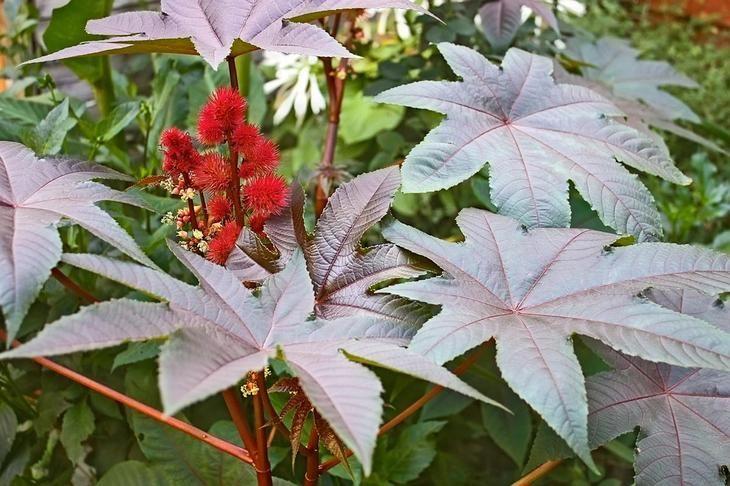

Among the diseases, bacteriosis, powdery rose, late blight, and various fungal diseases are periodically encountered. Treatment in this case is typical - the affected areas are removed and burned. Healthy parts are sprayed with Bordeaux mixture or fungicides.
Seed preparation for sowing
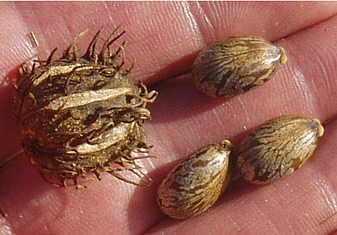

Before sowing, the seed must be prepared. If you look closely, you can see that the plant has taken good care of its seed. It has a very dense shell. In order for the seed to germinate, the shell must be damaged, broken. Then moisture will penetrate into the seed, and it will start to grow.
To break the integrity of the shell and not damage the base, it is enough to rub it with coarse-grained sandpaper. Some manage to scrape with a fine grater, or just scratch with a knife.
The scarification process carried out in this way will allow the semen to awaken 1.5 - 2 weeks earlier.
Soak the seed in warm water. You can also use a solution of stimulants "Epina", "Cercona", "HB - 101". Soaking time 1 - 2 days.
Growing - planting and care
Castor bean is planted in most cases in open ground, although there is also a practice of growing it as a tub house plant. In this regard, it will not be superfluous to once again warn about the extreme toxicity of this culture in direct contact with parts of the plant and, especially, if its poison gets inside. And the plant itself prefers open places with permanent air movement.
Choosing a landing site
Remember that the plant is a resident of the subtropics, so it needs to be provided with light and heat.When planted in a shaded place, the bush will have an unattractive elongated shape with an empty middle and will not have time to bear fruit. This does not look very pretty, and can lead to the fact that in strong winds the hollow trunk easily breaks. The brightness of the lighting largely determines the color of the leaves. In the sun, they acquire their red tint and special gloss. In the shade, the leaves are usually colored with a predominance of green.
The southeast location from the walls of the house, hedges and other high barriers is considered optimal.
Priority locations of castor bean plantings on the site
- On both sides of the porch at the entrance to the house, gazebo, bathhouse or other garden structure.
- In the form of a hedge in the corners or around the perimeter of the infield.
- Single plantings on lawns, banks of artificial reservoirs, like a tapeworm in the center of a flower bed.
Location rules
- The castor oil plant is not planted next to other large-sized plants claiming the role of a "star" of landscape design, they will interfere with the visual perception of both.
- This plant should not be planted near low hedges or as a substitute if children or livestock can reach them on the other side of the fence.
- There is no need to plant a large number of castor bean plants unless the purpose of planting is to create an artificial fence. Often three looks more impressive than a dozen, this is quite enough to create a tropical accent in the landscape.
- It is necessary to take into account the spreading dimensions of the bush, therefore, the radius of free space should be left at the rate of at least 1-1.5 m.
- The plant has a long taproot, however, this does not give it much resistance due to the hollow structure of the shoots. Therefore, in places where strong winds blow, it is better not to plant single specimens.
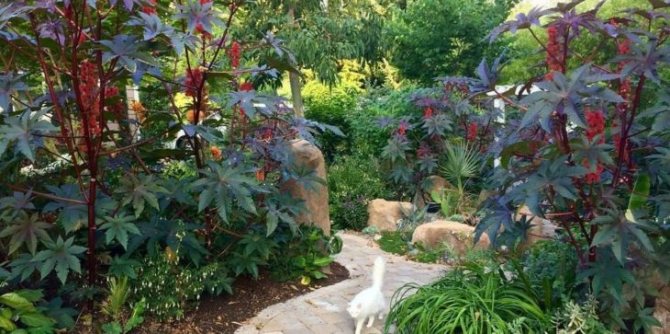

Soil requirements
The rapid growth of castor beans requires good nutrition. The soil should be rich in humus, loose, preferably gray or black. Light soils with a high sand content and clayey soils are not suitable for this crop. With a high density of the earth, humus, compost, leafy earth are introduced into it. If it is possible to pour a ready-made composition for decorative flowering plants into the planting hole, this will be the best option.
Watering and feeding
The plant requires frequent watering. Drying out of the soil is especially harmful during the period of active vegetation and flowering. Pour at least a bucket of water under each bush. It is best to do this in the morning.
It is advisable to apply organic fertilizer immediately before planting castor bean in open ground by laying a planting pit at the bottom. If you want to achieve abundant fruiting, then during the budding period you need to add nitrogen fertilizers to the soil, and a little later - a potassium-phosphorus composition. Mulching with wood ash of its near-stem circle will significantly improve the well-being of the bush.
Wintering and disposal of plant residues
Castor oil plant does not hibernate in cold climates and is grown exclusively as an annual. Therefore, in the fall, its plant residues must be disposed of. Do not put them in compost or use them as mulch for other crops, keeping in mind their toxicity!
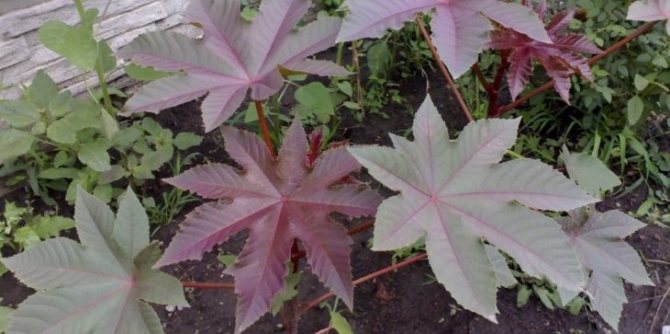

Why is castor oil useful and harmful?
The main benefit of ricina is its ability to beautify any garden plot.
The plant is very beautiful, creates a lot of shade in which you can hide from the heat in the summer. But the list of positive characteristics of the castor tree does not end there.
Leaves, flowers and seeds are used to create original and unique compositions. Pictures and various volumetric crafts are made from parts of the plant, used in herbarium.
The main advantage of castor bean is its seeds, which fully ripen by the end of summer. Essential oil is extracted from them for personal use and on an industrial scale.
This product is widely used in the pharmaceutical and cosmetic industry. This demand is due to the unique composition of castor oil.
Ricin oil consists of the following components:
|
|
|
For medical purposes, castor oil is used as a laxative for constipation.
Ricin oil helps well with inflammatory processes in the gastrointestinal tract.
It is also used as an external agent in the treatment of herpes, hematomas, wounds and burns. The oil envelops damaged tissues, protects them from external infection, has antiseptic and anti-inflammatory effects.
Castor oil has a very long shelf life due to the presence of natural preservatives and antiseptics in the composition. You can store the oil for several years in a dark place with the lid tightly closed.
If you comprehensively consider what a castor oil plant is, the benefits and harms of this plant will become obvious.
But it is necessary to dwell on its danger.
The seeds and leaves of the plant contain poison, which in large quantities can poison a person.
Consuming several seeds internally causes a condition close to coma. If you eat more than 20 ricin beans, death occurs.
Therefore, you should not plant castor oil plants where small children will play. They can mistake the seeds for berries and eat them.

